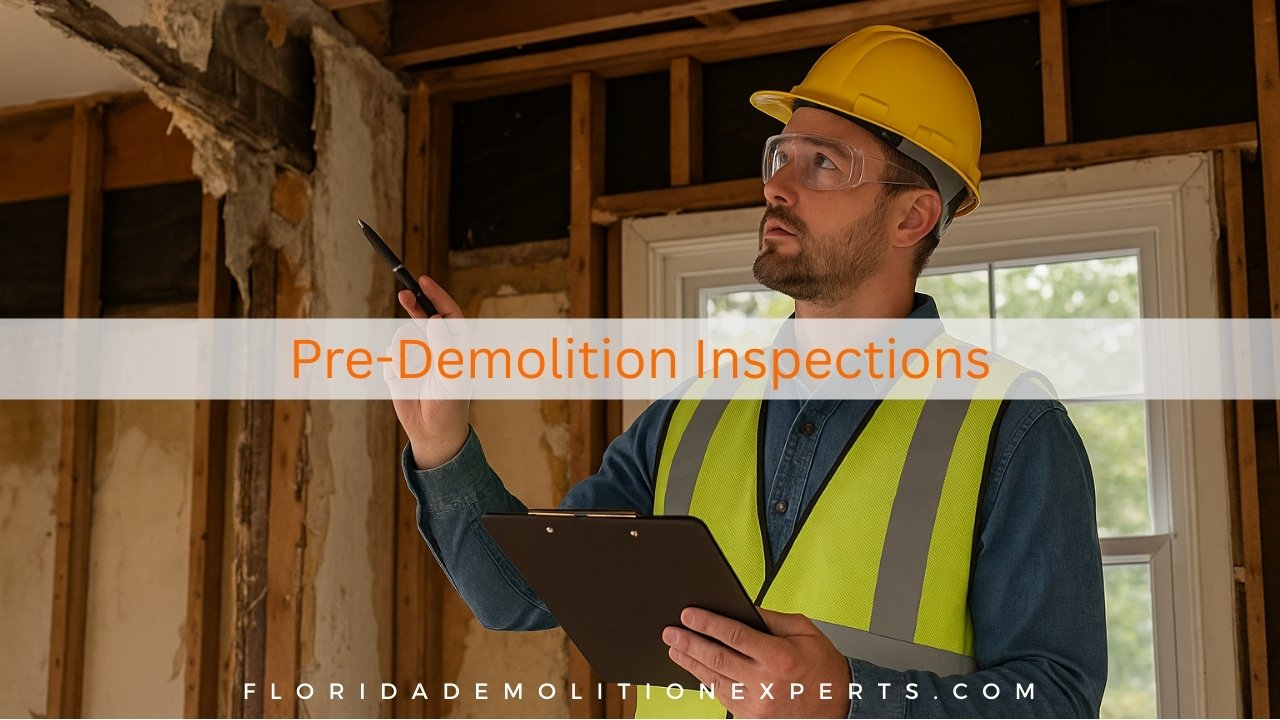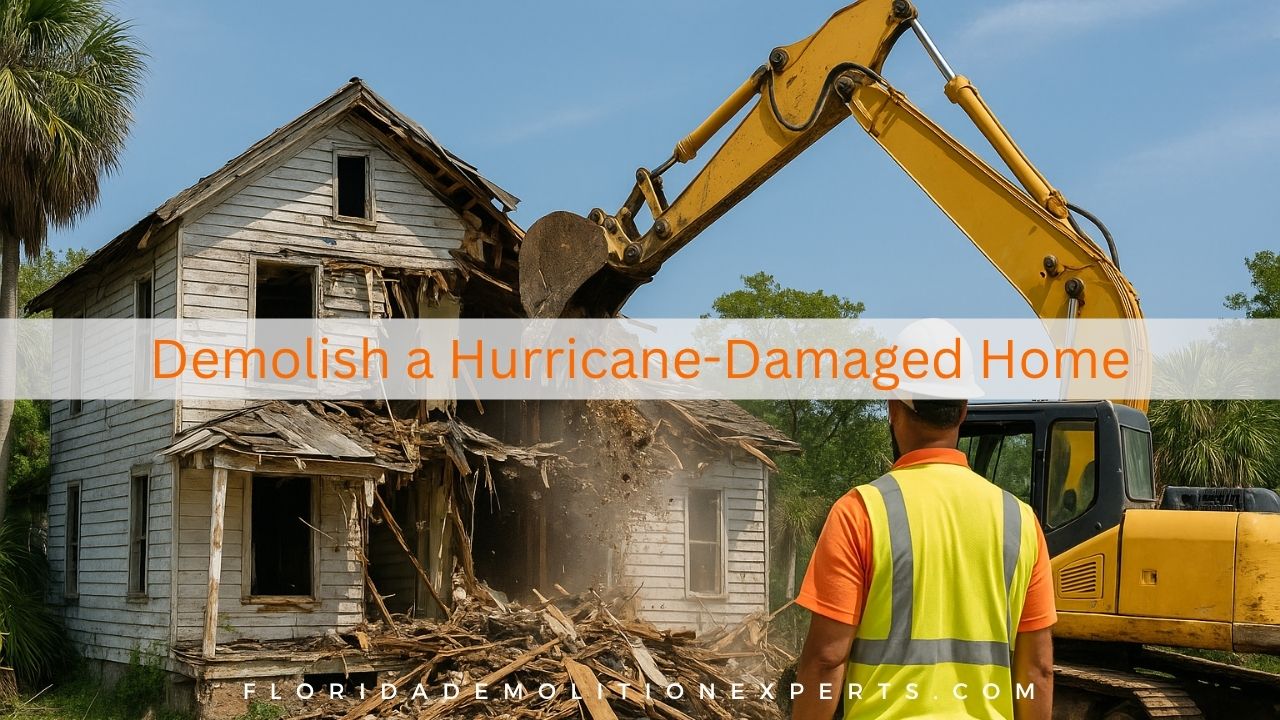Are you contemplating tearing down a house or a portion of one? Are you 100% sure what’s hiding behind the walls, under the slab, and in the paperwork?
A thorough pre-demolition inspection can be the difference between a smooth, on-schedule project and a budget-busting stall.
As a demolition specialist, I’ll explain a practical, homeowner-friendly approach that still meets the professional standards contractors and jurisdictions expect.
Why Pre-Demolition Inspections Matter
Before the first bucket or breaker touches the structure, you need to know three things:
- Can it come down safely? (structural stability, sequencing, utilities)
- What could hurt people or the environment? (asbestos, lead, mold, other hazardous materials)
- Are you legally clear to proceed? (permits, notices, liens, historical restrictions, neighbor and utility requirements)
Dialing these in early prevents surprise change orders, stops, and liability.
The Core Pillars of a Solid Pre-Demo Inspection
1) Structural & Site Assessment
- Load path & failure risks: Identify leaning walls, compromised floors, fire damage, rot, storm impacts, termite damage, and unpermitted add-ons that change how a structure must be taken down.
- Sequencing strategy: Decide what must be soft-stripped first (cabinets, fixtures, finishes), when to brace, where to cut, and how to stage equipment.
- Adjacent risk: Check clearances to neighboring structures, fences, trees, and utilities, and assess the potential for shared foundations or party walls.
- Access & logistics: Can trucks and machines get in/out safely? Confirm laydown areas, traffic control, sidewalk closures, and crane or high-reach requirements, if any.
- Utility mapping: Verify water, sewer, gas, electric, and telecom locations and shut-off points; mark and lock out before work starts.
2) Hazardous Materials Survey
- Asbestos: Common in older floor tiles, mastics, roofing, pipe insulation, popcorn ceilings, cement board, and siding. Requires a licensed survey and regulated abatement if present.
- Lead-based paint is frequently found in pre-1978 homes; demolition increases dust and exposure risks. Plan for compliant handling and disposal.
- Silica & dust: Concrete, brick, and mortar create respirable silica, which can be controlled with wet methods and negative air, and PPE must be specified.
- Mold & moisture: Identify water-damaged areas; plan containment to avoid spreading spores during soft strip.
- Other concerns are PCBs in old fluorescents/ballasts, mercury in thermostats, refrigerants in HVAC units, treated timbers, underground storage tanks (USTs), and unknown chemicals in sheds or garages.
3) Legal, Permitting & Compliance Review
- Demolition permits & sub-permits: Many jurisdictions require proof of utility disconnect letters, rodent abatement, tree protection plans, and site erosion control measures.
- Notices & posting: Neighbor notification, historic district reviews, and possible demolition delay ordinances.
- Property status: Title issues, liens, unpermitted structures, or easements that may affect the scope.
- Waste and transport: Confirm disposal facility acceptance, recycling targets, and transporter licensing; plan a waste manifest trail from the site to the final destination.
Step-by-Step: How Pros Structure the Inspection
- Document Review
- Tax records, prior permits, as-builts, add-on permits, past insurance claims, and engineering reports. (See Permit Guide in Florida).
- Site history: fuel tanks, fire events, flood zones, sinkholes, wetlands, protected species, or coastal setbacks.
- Exterior & Site Walk
- Grade, drainage, soil conditions, retaining walls, tree roots, hardscape, and outbuildings.
- Locate and flag utilities; call for locates where required.
- Interior Walk & Selective Openings
- Probe suspicious walls and floors; open test areas to verify framing, hidden voids, and potential asbestos/lead-containing layers.
- Sampling & Lab Testing
- Asbestos bulk sampling, lead XRF or paint chip sampling, and mold/moisture mapping. Maintain chain-of-custody and keep lab reports on file.
- Abatement & Soft-Strip Plan
- Define removal of appliances, fixtures, cabinets, carpets, doors, windows (for salvage), and hazardous components (for abatement).
- Demolition Method Statement
- Various methods are used, such as mechanical vs. deconstruction vs. hybrid, equipment list, sequencing, fall zones, dust/noise/vibration controls, and stormwater and erosion control.
- Safety Plan & Site Controls
- Site fencing, signage, exclusion zones, PPE, fire watch, first aid, and emergency egress routes.
- Waste & Recycling Plan
- Targets for concrete, metals, clean wood, brick, and asphalt shingles; identify local receivers and their requirements.
- Schedule & Neighbor Coordination
- Work hours, street/sidewalk closures, truck routes, and point-of-contact for complaints.
20-Point Pre-Demolition Inspection Checklist
- Permit matrix drafted (demo, tree, right-of-way, erosion control)
- Utility disconnects scheduled/verified (electric, gas, water, sewer, telecom)
- Site history reviewed (USTs, flood/fire events, historic status)
- Structural hazards documented (leaning walls, compromised floors, fire/rot/termite)
- Adjacent property risks assessed (shared walls, setbacks, vibration sensitivity)
- Access/egress and equipment staging planned.
- The asbestos survey was completed; the abatement plan was approved if needed.
- Lead-based paint testing was documented, and the handling plan is in place.
- Mold/moisture assessment was completed; the containment plan was defined.
- PCB/mercury/refrigerant handling identified
- Rodent/pest abatement (if required) scheduled and certified
- Dust, noise, and vibration control measures are specified.
- Stormwater/erosion control plan and inlet protection in place
- Tree protection and heritage tree permits (if applicable)
- Method statement and sequencing finalized.
- Safety plan (PPE, exclusion zones, fire watch, emergency plan)
- Waste & recycling plan with receiving facilities confirmed
- Truck routes and traffic control approved
- Neighbor notifications posted/sent (as required)
- Documentation package assembled (lab results, manifests, photos)
Common Pitfalls That Cost Time & Money
- We skip lab testing because “it looks new.” Materials are layered, and older asbestos/lead can sit under newer finishes.
- Assuming utilities are dead without written proof. One live service can halt the job or cause injury.
- Ignoring adjacent structures. Shared foundations, masonry party walls, or shallow footings change sequencing and bracing.
- No waste outlet lined up. Landfills and recyclers sometimes refuse specific materials without prior approval or appointments.
- Underestimating dust & stormwater. Neighborhood complaints and fines escalate fast without controls.
Pro Tips from the Demo Side
- Start permits early. Some jurisdictions require abatement sign-offs before issuing demo permits.
- Photograph everything. Pre- and post-condition photos protect you with neighbors and inspectors.
- Salvage first. Doors, windows, fixtures, and hardwood flooring can offset costs and reduce landfill.
- Write precise bid specs. If you’re soliciting bids, tie every requirement (testing, abatement, disposal, recycling) into the scope to compare apples to apples.
- Build a contingency (10–20%). Hidden hazards are common; plan for them.
FAQ
Do I need an asbestos or lead survey for a newer home?
Suppose any portion predates modern bans or uses suspect materials, yes. Renovations often leave older layers underneath.
How long does pre-demo due diligence take?
Document review and surveys can often be completed quickly, but abatement schedules and permit lead times vary by jurisdiction.
Can I stay in the house during abatement?
Generally no. Hazard abatement and structural work require controlled areas and specialized containment.
Mechanical demolition vs. deconstruction: what’s better?
Mechanical demo is faster and cheaper; deconstruction increases salvage and can reduce disposal. Many projects use a hybrid approach.
Your Next Step?
If you want this process handled by seasoned pros from the first site walk and sampling to the final clearance, Florida Demolition Experts can help. Well:
- Perform a complete pre-demolition inspection and hazard survey.
- Coordinate utility disconnects, permits, and neighbor notices.
- Develop a safety-first method statement and recycling plan.
- Deliver a clean, compliant, on-schedule teardown.
Ready for a stress-free demolition?
Contact Florida Demolition Experts for a free pre-demo consultation and site walk. We’ll review your goals, flag risks upfront, and give you a clear, fixed-scope plan that protects your budget and timeline.






